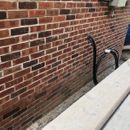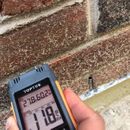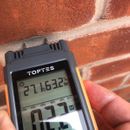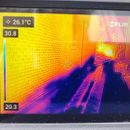Brick Moisture Issues
Hello, we have just finished the brick siding on a new build house, and I’ve noticed that the brick/mortar are discoloured in some areas. Upon further inspection it looks like the bottom 5-6courses of brick are slightly more wet in some areas (refer to attached photos). I have used a moisture meter on the mortar and readings range from 6-12% in the wet areas, while the rest is 2-3%. I also looked at it through a FLIR camera (see photo) and it’s clear that some sections of the wall have a higher moisture content.
The brick has a moisture block membrane at the foundation all around and weep holes every 24” or so. What could be causing this issue? Could the weep holes be blocked with excess drip of mortar, or could there be something else causing this? We have very good flashing so no moisture is coming inside yet, but I’m still worried on how to address this.
Also the foundation below the brick sometime has lower moisture reading than the brick above, so I doubt it’s coming from the foundation, especially since the moisture block membrane would block it.
Your advice and help would be greatly appreciated.
Also if the weep holes are not draining properly, what would be the best way to fix it?
GBA Detail Library
A collection of one thousand construction details organized by climate and house part














Replies
I have gotten the masonry company to take off a few courses off brick. It was definitely damp under there with the Rockwool a bit damp but not dripping wet. See attached a few photos of different areas.
I noticed that here was perhaps a bit too much mortar drip in the air gap which which likely impeded airflow, and slowed down the drying. Also the most affected areas are the one closest to the ground as we haven’t yet graded everything properly.
The plan here is to remove the first 5-6 courses of bricks all around the house, clean up any mortars droppings, add more wall through flashing where missing and put the brick back.
Let me know your thoughts on the cause and proposed fix. Is the fix a bit excessive, or is there anything else you can suggest. I have attached some photos of the mortar bridging. I think the masonry crew could have been a bit more careful in this regard.
That looks pretty close to grade and next to a retaining wall. Is there eavestroughs on the place yet? Looks a lot like splash back.
Also if there is running water between the houses would create issues if the bricks are close to grade.
With MW behind the brick I would not be worried about draining path blocked by mortar, MW itself is a great drainage plane.
If site draining is fine and there are eavestroughs, I would still give it a bit of chance to dry up before taking the wall apart.
Thanks Akos. Our property is on a slope and then brick at the front of the house is closer to grade, while the back is 12” above grade. We have also not done any landscaping and graded everything properly. Also, the eaves are not in yet, so there is definitely a good amount of backsplash there. There is not much running water though.
That said, it’s been almost a week of hot weather with no rain, and some of these areas haven’t dried yet. I would assume by now it should be completely dry, as is all of the brick above.
What do you mean by “MW”? Also would you recommend that I add more weep holes? Perhaps some a foot or two above the ground for extra ventilation? Thanks
R404.1.6 Height Above Finished Grade
Concrete and masonry foundation walls shall extend above the finished grade adjacent to the foundation at all points not less than 4 inches where masonry veneer is used and not less than 6 inches elsewhere. (FYI - Some municipalities have 8" minimum)
I also specify NO sprinklered landscape within 3 feet of the house. Small drip irrigation is acceptable on individual plants. Make sure you have weep-holes every third brick.
Your home Designer/Architect should have had this detail on the drawings. Your Builder should know this... This is basic stuff of every house.
It's a shame you are saddled with this problem.
Hi Armando, agree with you. That said we haven’t done the landscaping yet.
Once graded properly, I think we will have the brick about 4” above grade at the minimum, and about 12” in the back, where the property slopes down.
We are also thinking of pouring cement all around the sides of the house and slope it away from the house for added protection and as a walkway. We get quite a bit of snow in the winter too, so it will be important to get the water away from the house.
Agree it’s a shame they as a homeowner I have to basically oversee that things get done right, rather than being able to rely on the experts and trades that we are paying quite a bit for.
"the eaves are not in yet" There is your problem. Get these in and the brick will dry up.
Brick takes a long time dry when saturated like that, a week of sun is not enough. Things would have been a lot better if they would have stuck to code min ground clearance as Armondo pointed it out.
Once you have the gutters in, you can check with your probe to see if the moisture content is decreasing. If it is, you are fine.
P.S. MW=mineral wool
Agree with Akos - "the eaves are not in yet" is part of the issue. Will there be gutters on the eaves?
At this point, I would work out a deal with the mason that they don't need to redo this UNLESS the problem does not go away / measurably decrease and continue decreasing several weeks AFTER the completion of the eaves, the landscape grading and some time of no precipitation. If the issue persists after that, they need to redo this.
For future reference, mortar net tends to help avoid this type of issue by maintaining a drainage plane directly behind the weeps.
Thanks everyone. Agree with Akos and user 6022 that gutters are definitely part of the issue. Once we put them in, it should minimize the wetting. That said, I do think it should be drying out a bit faster. The damp area isn’t decreased at all, but now that we’ve opened it up it’s drying fast.
The masonry company will replace the first 5-6 courses of brick in the most affected areas, cleaning out the mortar bridging and adding weep holes every 12” for added drying. Should I tell them to add a mortar net in those areas, or is that a moot point now that we’re only doing the first 5-6 courses of brick?
Also would you recommend we put more wall through membrane in areas where it doesn’t go beyond the foundation wall?
I don't think you have a brick problem. Not much sense in ripping it out, get the gutters on first.
Thanks Akos, agree and we won’t rip out much of the brick,
mostly just the front of the house. In the front of the house, they put the wrong through wall membrane as well. It’s a 4 perm window flashing membrane for sides of window frame (not suitable for sills).
As such it’s wicking moisture from the foundation wall into the brick and has already started to disintegrate (see attached photo).
I think the front we’ll have to replace as a result. Either way it should be a couple of days of work. If the crews leave and I pay in full, it might be tough to get them back for any add’l fixes.
Any reason to put the mortar net now in the fixed areas, or is there no point now?
Yes, have them put the mortar net in, after they replace the flashing membrane and before they reinstall the brick. Otherwise you will never know if the new brick can actually weep - especially if they are installing brick under other brick and wedging mortar in there. Very easy to get too much in there trying to make it look correct from the front. The mortar net can't hurt anything and cost is miniscule compared to the labor of doing this.
Also, it is typical to pay subs "complete" for their work less 10% retainage. The last 10% retainage is not paid out until you are sure all of their work is properly installed. You can't be sure the masonry is properly installed until after you get the gutters installed.